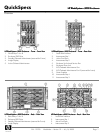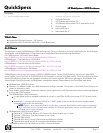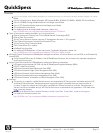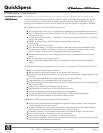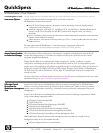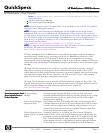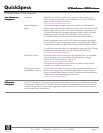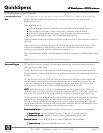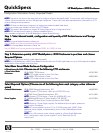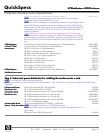
NOTE:
NOTE: NOTE:
NOTE:
For a brief, printer friendly data sheet that describes this product and informs you of the essential capabilities and
specifications, please visit:
http://h71028.www7.hp.com/erc/downloads/4aa0-5978enw.pdf
HP BladeSystem Overview
HP BladeSystem OverviewHP BladeSystem Overview
HP BladeSystem Overview
As server, storage and network technologies have changed; traditional rack-mounted infrastructure
solutions have generated increased complexity of both infrastructure management and physical
datacenter deployment.
HP BladeSystem is the evolution of rack-mounted and pedestal infrastructure. A BladeSystem reduces
costs and simplifies the management, building, and maintenance of the infrastructure behind your multi-
server environment. It consolidates and repackages all the supporting infrastructure elements-compute,
storage, network, and power into a single platform that can accelerate the integration and optimization
of your data center.
The HP BladeSystem c3000 enclosure has the flexibility to scale from a single enclosure holding up to 8
blades, to a rack containing 7 enclosures holding up to 56 blades, the c-Class infrastructure is designed
to meet the needs of today's businesses. The c3000 enclosure is designed for several markets:
Remote sites or branch offices holding between 3 and 8 servers, and in deployment sites such as
retail stores, branch offices, manufacturing sites, and wiring closets. This enclosure is also
designed for harsh environments not found in modern datacenters (high ambient temperatures,
dusty environments, and in ships, airplanes, platforms, and vehicles).
Small and medium businesses, who own between 3 and 100 servers. The enclosure is designed
for use with management devices such as local KVM switches for local administration.
Datacenters with special power and cooling constraints, such as datacenters needing DC powered
racks, and/or datacenters with low power & cooling capacities (under 3000 watts per rack).
HPC clusters with InfiniBand interconnection, where the applications need a 1 to 1 IB network
subscription ratio between physical nodes in the compute cluster.
HP BladeSystem c-Class infrastructure is made up of several components:
HP ProLiant and/or HP Integrity Server blades for HP-UX, Windows, Linux, and HP Open VMS.
Choice of Intel® or AMD processors, including the latest dual-core & quad-core processors for
32-bit and 64-bit applications.
HP BladeSystem c-Class enclosure (either a c7000 or c3000) that provides connectivity, power,
and cooling options. The c-Class enclosure is designed for full redundancy and high availability. A
configurable choice of either redundant or non-redundant power, cooling, enclosure
management, and interconnect modules are part of the standard enclosure design.
Onboard Administrator module which provides a single point of control for intelligent
management of the entire enclosure.
Insight Display powered by the Onboard Administrator provides local management through an
LCD display conveniently sited on the front of the system.
Virtual Connect, Ethernet, Fibre Channel, InfiniBand, iSCSI, and other interconnect choices
A power subsystem that provides either redundant or non-redundant power modes and Dynamic
Power Saving mode, which uses up to 30% less power than traditional rack-mounted and tower
servers.
PARSEC (Parallel, Redundant, Scaleable, Enclosure Cooling) architecture: for maximum cooling
that consumes less power and reduces datacenter noise.
Direct-attach storage blades, and shared storage blades, which will provide file-based or block-
based shared storage capacity for the servers within the enclosure.
QuickSpecs
HP BladeSystem c3000 Enclosure
HP BladeSystem c3000 EnclosureHP BladeSystem c3000 Enclosure
HP BladeSystem c3000 Enclosure
HP BladeSystem c-Class Overview
DA - 12790 Worldwide — Version 12 — July 14, 2008
Page 5



